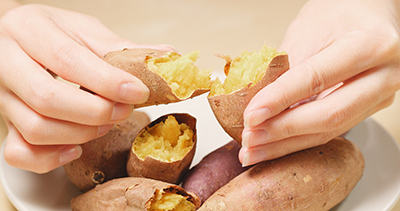Contents
Before we get into the many sweet potato health benefits, let us dig deeper into the history of this delicious yet medicinal food. Although the sweet potato belongs to a different botanical family than the potato, these tubers have many features in common: their physical form (the sweet potato is longer and narrower) and their flavor. The sweet potato is, obviously, sweeter. This is why the sweet potato has its name.
Tremendous amounts of sweet potato are eaten in Central America, particularly Haiti, its point of origin. The Spaniards introduced it to Europe, from where it has spread worldwide.

Nutritional Facts
The composition of the sweet potato is dominated by carbohydrates, which constitute approximately 21.3 percent of its weight. These carbohydrates are in the form of sugars and starch (especially saccharose) in different proportions, depending on the variety: the more saccharose, the sweeter the tuber.
Their fat and protein content is minimal, less than that of the potato. However, they are vibrant in beta-carotene (provitamin A), particularly in the more yellow varieties. The sweet potato is quite digestible, although it must be well chewed to mix with saliva.
The sweet potato contains an appreciable amount of cellulose-type fiber. In contrast to other vegetables like potatoes, this fiber is made of hemicellulose, not cellulose. Hemicellulose is more soluble and softer than cellulose. This makes the sweet potato highly desirable and has a soothing effect on the intestinal walls. Sweet potato health benefits comprise the following three dietetic and therapeutic applications:
Health Benefits

OBESITY – Contradictory though it may seem, consumption of sweet potatoes protects against obesity. It is a starch-rich food with many calories (a little more than a potato). However, they have a property that makes them very useful in obesity: they produce a sensation of satiety. Consumption of one hundred grams (about 3.5 percent) of sweet potatoes, which provides only 105 kcal, can relieve hunger for several hours.
One of the causes of obesity is that individuals do not feel satisfied after eating an average amount of food. The sweet potato aids the obese in reducing caloric intake by producing a full sensation in the stomach and reducing appetite. Of course, eating sweet potatoes in controlled amounts is necessary not to exceed the recommended daily caloric intake.
FATS are the foods that produce the most incredible sense of satiety. Usually, when individuals have an empty feeling in the stomach, they seek to relieve it with foods rich in fats, which leads to obesity. Sweet potatoes have the same satiating effect but virtually no fats and fewer calories. Of course, sweet potatoes should not be the staple of the diet because of their lack of fats and proteins. However, they are nutritious and filled with milk, legumes, or oil-bearing nuts.
ARTERIOSCLEROSIS and circulatory disorders: Sweet potatoes’ richness in beta-carotene makes them very beneficial in cases of arteriosclerosis. This provitamin is known to protect the inner lining of the arteries, whose degeneration, produced by cholesterol deposits, results in arteriosclerosis. Sweet potatoes are almost totally lacking in saturated fats and sodium, the two most pernicious enemies of the circulatory system. Regular sweet potato consumption is recommended in cases of arteriosclerosis, lack of adequate blood flow, and hypertension.
INCREASED NEED FOR ENERGY—Sweet potatoes are a great energy source for those involved in intense physical activity, athletes, and those recovering from debilitating diseases. In these cases, sweet potatoes may be eaten as the primary dish at dinner two or three times a week.
Warning
Sweet potatoes should be avoided or used in moderation:
- Those who suffer from intestinal fermentation and excess gas, particularly when they are not well chewed, can foster this type of disorder.
- Diabetics, because this tuber is rich in carbs (starch and sugars) that are released and absorbed quickly.

Digestion of Carbohydrates
Carbohydrates, almost the only nutrient in sweet potatoes, are digested in the mouth. Ptyalin, a saliva enzyme, breaks down the large starch molecules into shorter ones called maltose and dextrose.
The enzyme amylase from the pancreatic juice breaks down these starch molecule fragments into their elemental constituents: glucose molecules.
Scientific Facts
- Scientific name: Ipomoea batatas (L.) Poir.
- Other names: Batata [dulce], Camore, Kumara.
- French: Batate [douce]
- Spanish: Batata, boniato, papa dulce.
- German: Süßkartoffel.
- Description: Tuber of the sweet potato, a perennial herbaceous plant of the botanical family Convolvulaceae, with trailing vines reaching a height of 30 cm to 1 m.
- Environment: Sweet potatoes are grown in every tropical and subtropical region. It requires long, relatively dry summers.

How to Use and Prepare
- OVEN-ROASTED – This is the most common preparation. They may also be roasted over coals. They must be roasted whole without removing the peel.
- PUREE WITH MILK—Once sweet potatoes are roasted or cooked, they are mixed with milk to a consistent paste. Because they are generally sweet enough, especially if yellow, there is no need to add sugar. Adding egg yolk can increase their nutritional value.
- PASTRY – Sweet potatoes make various delicious products such as jams and candies.
DISCLAIMER: All content on this website is presented solely for educational and informational objectives. Do not rely on the information provided as a replacement for advice, diagnosis, or treatment from a qualified medical expert. If you are pregnant, nursing, or have any preexisting medical concerns, talk to your doctor before using any herbal or natural medicines.
REFERENCES
- George D. Pamplona-Roger, M.D. “Encyclopedia of Foods and Their Healing Power.” George D. Pamplona-Roger, M.D. Encyclopedia of Foods and Their Healing Power. Trans. Annette Melgosa. Vol. 2. Chai Wan: Editorial Safeliz, 2005. 301, 302. Print.
- National Institutes of Health: https://www.ncbi.nlm.nih.gov/pmc/articles/PMC3951003
- National Institutes of Health: https://www.ncbi.nlm.nih.gov/pmc/articles/PMC5858653
- Journal of Functional Foods: https://pubmed.ncbi.nlm.nih.gov/26851898
Last update on 2025-06-04 / Affiliate links / Images from Amazon Product Advertising API





